Connecticut is the third smallest state in America, and the fourth most densely populated. Despite this, there are still many areas of unspoiled nature, including protected areas such as the Appalachian National Scenic Trail, and the Quinebaug, and Shetucket Rivers Valley National Heritage Corridor.
The low-lying coastal areas and Connecticut river valley offer fairly mild winters that make the state one of the northernmost common overwintering grounds for many migratory bird species such as sparrows.
Among the 15 sparrows that live here, a fairly even number are summer migrants, winter migrants, and those that remain here all year round.
While some species of sparrow are fairly shy and prefer a secluded life in wild grasslands, others are common city birds and will readily accept food from your backyard bird feeder in winter, or take a dip in your bird bath or garden pond during hot summer days.
Because these ‘little brown jobs’ often look so similar, it can be useful to learn their field marks and songs to identify them. Pay close attention, then, to our top ID tips in our comprehensive list!
Sparrows Species in Connecticut, Starting With the Most Commonly Seen
Song Sparrow

- Scientific Name: Melospiza melodia
- Length: 4.7-6.7 in (12-17 cm)
- Weight: 0.4-1.9 oz (12-53 g)
- Wingspan: 7.1-9.4 in (18-24 cm)
Song sparrows are the most frequently spotted sparrow in Connecticut, and also one of the most common in the entire United States.
Although they look similar to other sparrows, especially their cousin, Lincoln’s sparrow, these medium-sized sparrows can be identified by their song which is almost constant during the spring and summer when these birds nest in the state.
Since Connecticut lies in the middle of their breeding grounds to the north, and overwintering grounds to the south, song sparrows can be seen here all year round, although they’re slightly more common during the summer.
House Sparrow
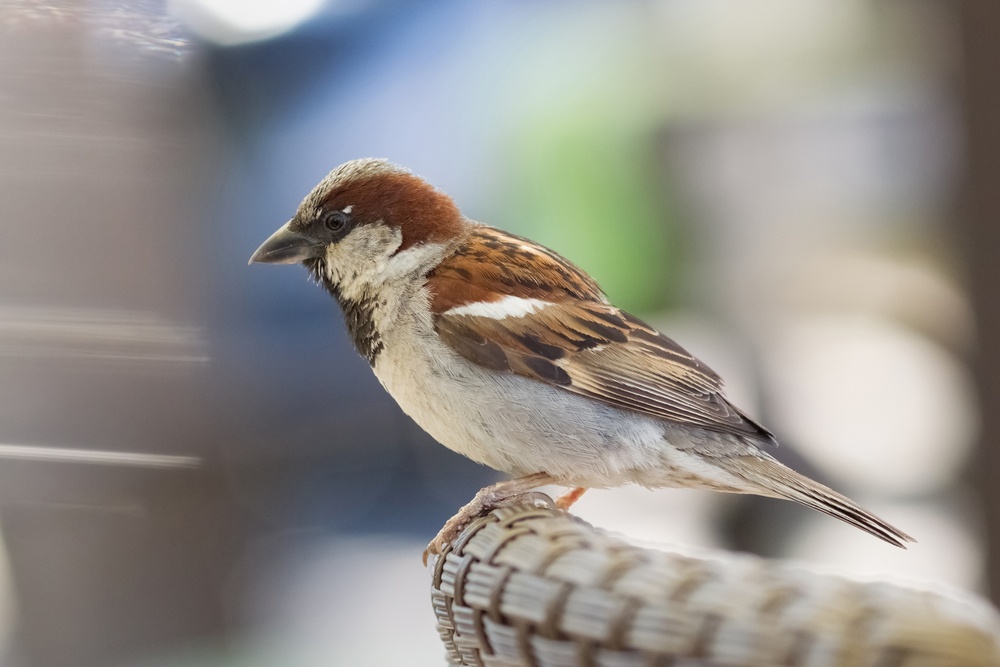
- Scientific Name: Passer domesticus
- Length: 5.9-6.7 in (15-17 cm)
- Weight: 0.9-1.1 oz (27-30 g)
- Wingspan: 7.5-9.8 in (19-25 cm)
House sparrows are in a different family to all the other sparrows on our list, and that’s because they’re not native to America, but were introduced from Europe in 1852.
It’s not surprising then, that they behave differently to most native sparrows, too. House sparrows never migrate, but instead, remain year-round in the same localities where they can be quite territorial.
This assertive behavior has caused problems for native birds that sometimes lost their nest sites to these boisterous birds!
Nevertheless, house sparrows have their charm and their cheerful chirps can often be heard around human habitation. They love visiting backyard feeders and a hungry flock will readily finish off a table of black oil sunflower seeds in minutes!
White Throated Sparrow
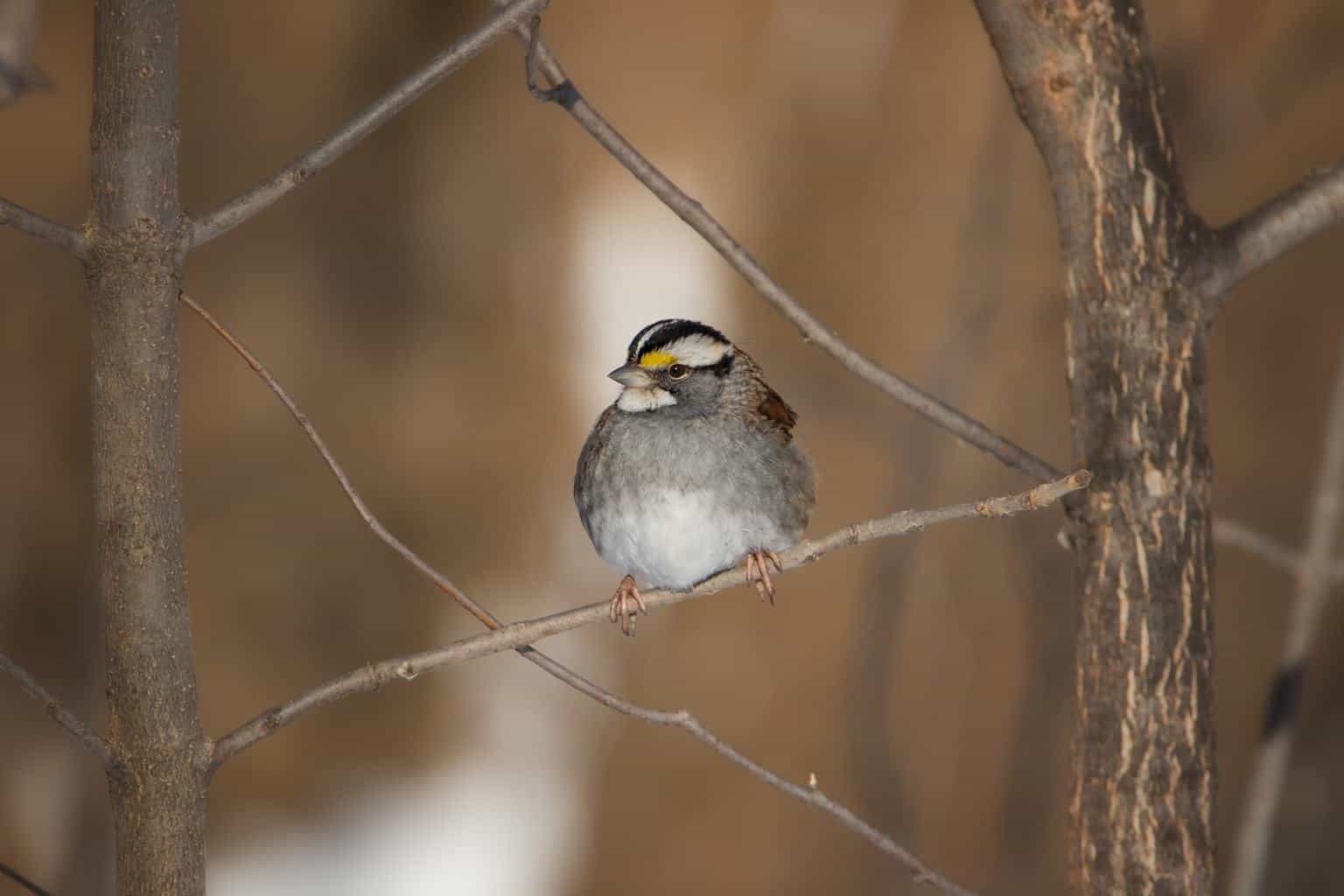
- Scientific Name: Zonotrichia albicollis
- Length: 6.3-7.1 in (16-18 cm)
- Weight: 0.8-1.1 oz (22-32 g)
- Wingspan: 7.9-9.1 in (20-23 cm)
White-throated sparrows are a very common winter resident in Connecticut and are the most frequently seen bird at woodland bird feeders on the east coast. You can attract them to your backyard by offering them millet and black oil sunflowers seeds at your feeder.
- Sibley Guide To Birds, 2nd Ed
- Sibley, David Allen (Author)
- English (Publication Language)
Last update on 2024-04-23 / Affiliate links / Images from Amazon Product Advertising API
These medium-sized sparrows are easily recognized by their black and white/tan striped heads and yellow eyebrows. They also have a distinctive, slightly mournful whistle that’s easy to impersonate!
Dark-eyed Junco
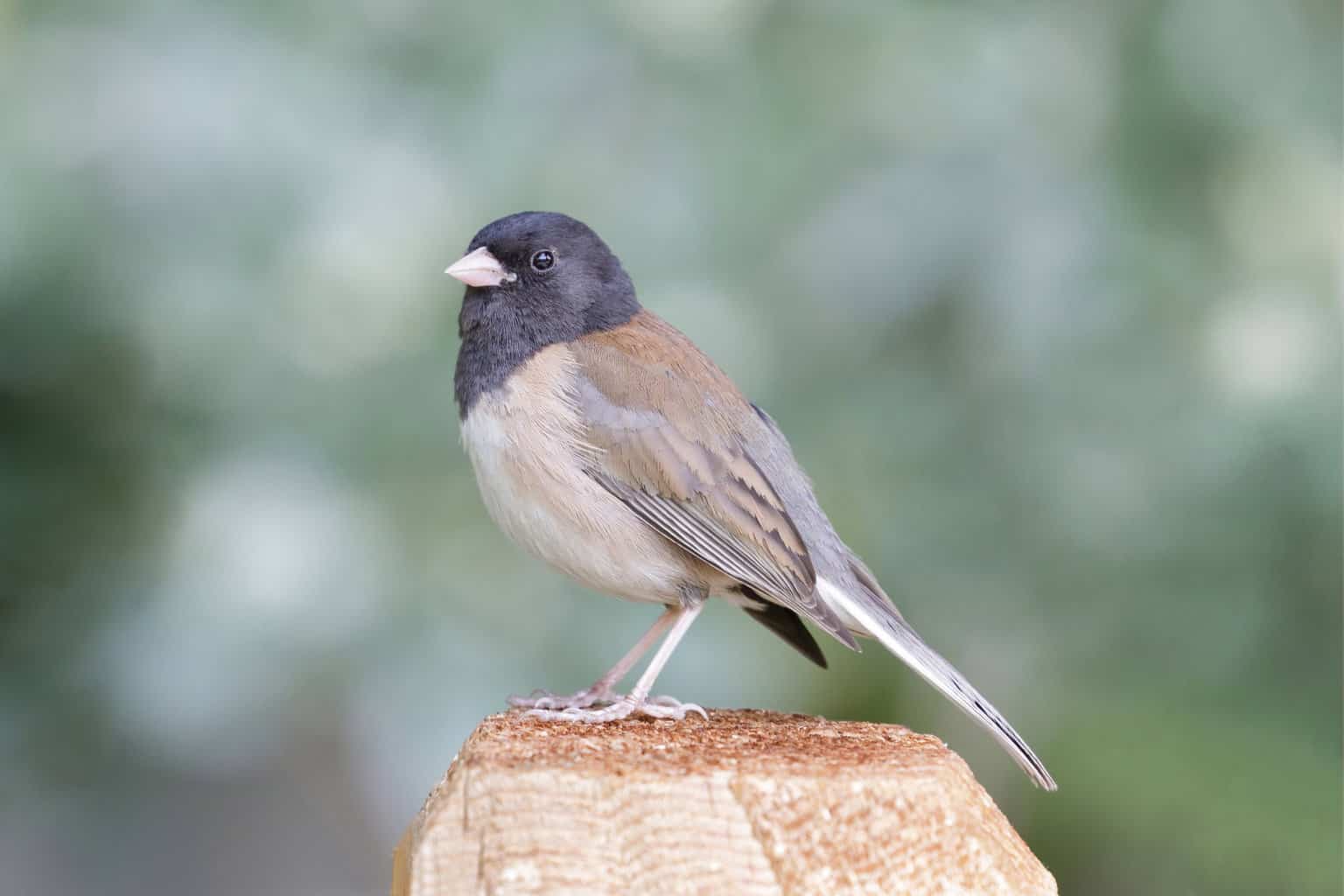
- Scientific Name: Junco hyemalis
- Length: 5.5-6.3 in (14-16 cm)
- Weight: 0.6-1.1 oz (18-30 g)
- Wingspan: 7.1-9.8 in (18-25 cm)
Dark-eyed juncos are a genetically diverse species of sparrows that, according to my Sibley Guide To Birds book, consist of six distinct subspecies. By far the most common in Connecticut are the slate-colored branch, but occasional sightings of wandering Oregon dark-eyed juncos are also possible here.
As their name suggests, male slate-colored dark-eyed juncos are dark gray, but females also have light brown feathers on their wings and back.
These birds are present year-round in the northeastern states, even overwintering in the northern half of Canada. Their hardy character has earned them the name ‘snowbird’.
Chipping Sparrow
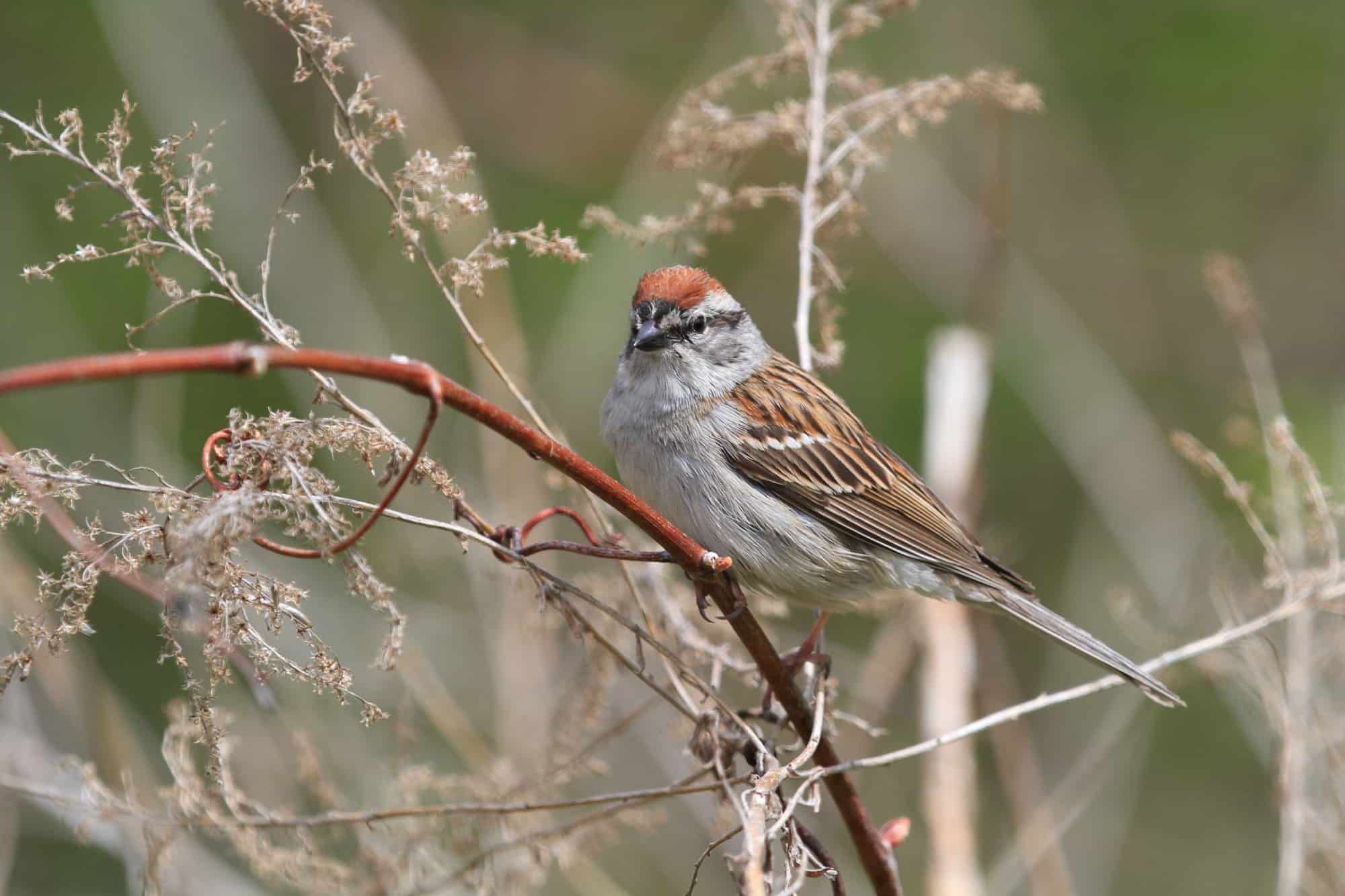
- Scientific Name: Spizella passerina
- Length: 4.7-5.9 in (12-15 cm)
- Weight: 0.4-0.6 oz (11-16 g)
- Wingspan: 8.3 in (21 cm)
Chipping sparrows are small, common birds with long, thin tails and pinkish bills
They can be told apart from other members of their family by their long, dark eye line that becomes especially apparent in the spring and summer when they show off their breeding plumage.
This is when you’ll see the chipping sparrow in Connecticut, nesting in trees in sparse woodlands and suburban parks. They overwinter in the Southern United States and Central America.
Eastern Towhee

- Scientific Name: Pipilo erythrophthalmus
- Length: 6.8-8.2 in (17.3-20.8 cm)
- Weight: 1.1-1.8 oz (32-52 g)
- Wingspan: 7.9-11.0 in (20-28 cm)
Although eastern towhees are present around the year in Connecticut, you’re much more likely to see them during the summer, when large numbers of them come to nest here.
Beautiful birds with a white belly and red underwing, female eastern towhees have a more brownish plumage than the jet black males, but otherwise, the sexes look much alike.
Unlike the white-eyed eastern towhee of the southern states and the spotted towhee of the west, the variant you’ll find in Connecticut has dark ruby-red eyes.
One of the largest sparrow species on our list, eastern towhees are fairly solitary birds and like to forage in the undergrowth for insects and seeds as large as acorns!
Swamp Sparrow
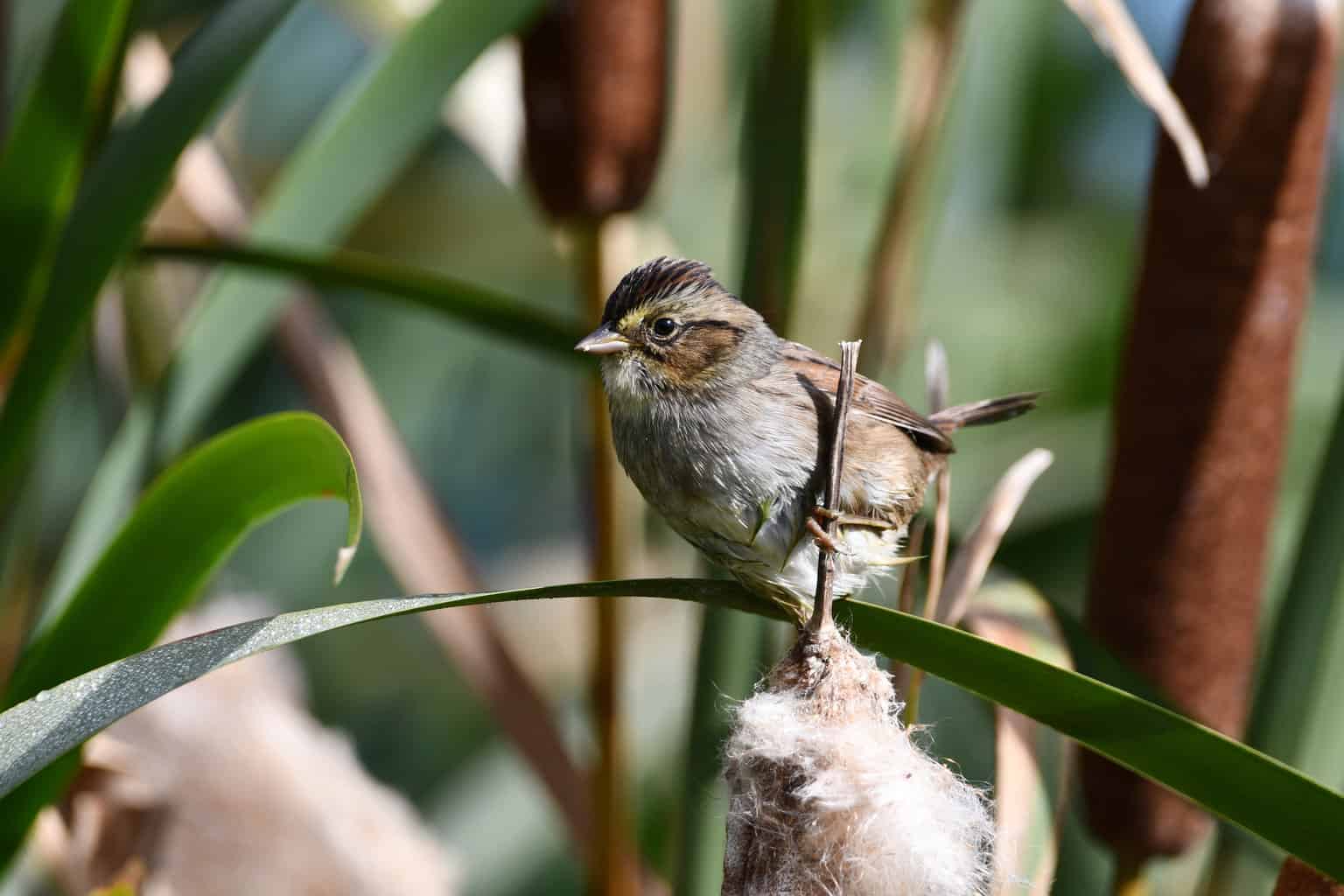
- Scientific Name: Melospiza georgiana
- Length: 4.7-5.9 in (12-15 cm)
- Weight: 0.5-0.8 oz (15-23 g)
- Wingspan: 7.1-7.5 in (18-19 cm)
As their name suggests, swamp sparrows like spending their time around wetland habitats such as marshes and edges of ponds and lakes. Here you can find these tiny birds hiding among dense vegetation, such as cattails and wetland shrubs.
They can also occasionally be attracted to backyards by offering them a bird bath.
These tiny birds are difficult to spot and identify, but their laugh-like, high pitch song is a good way to locate and recognize them.
Since Connecticut lies right at the center point between its summer and winter grounds, it’s one the few states where you can find swamp sparrows all year round.
Savannah Sparrow
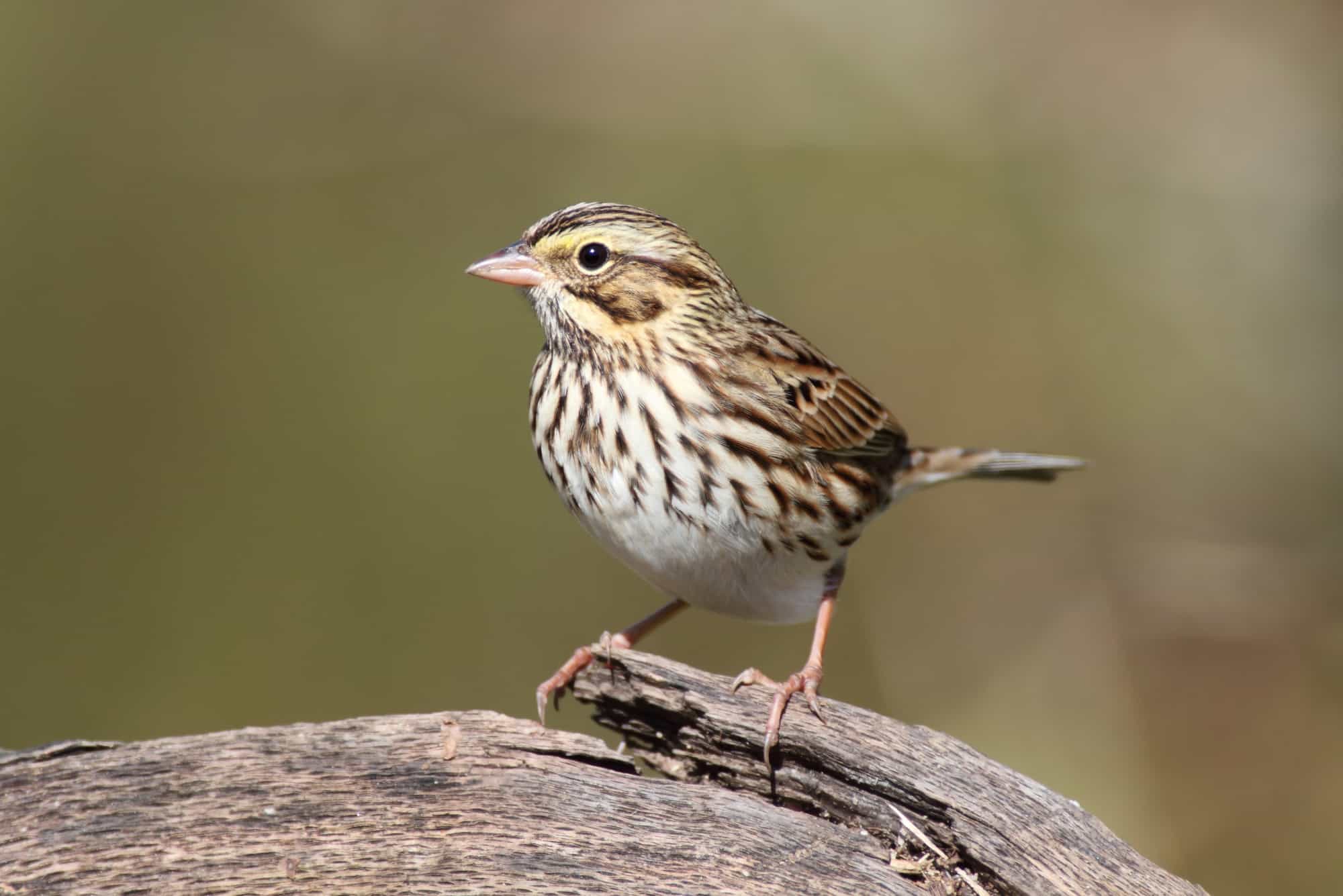
- Scientific Name: Passerculus sandwichensis
- Length: 4.3-5.9 in (11-15 cm)
- Weight: 0.5-1.0 oz (15-28 g)
- Wingspan: 7.9-8.7 in (20-22 cm)
One of the most widespread of all sparrow species, there’s hardly a corner of North America where you can’t find the savannah sparrow.
There’s not a huge population of savannah sparrows in Connecticut, perhaps owing to the lack of savannah-like grasslands that these birds prefer. Interestingly though, this part of America is one of the few places where this species can be found throughout the year.
Savannah sparrows may look similar to song sparrows from a distance, but a closer look through a pair of binoculars reveals the light yellow feathers around their eyes is their primary field mark.
American Tree Sparrow
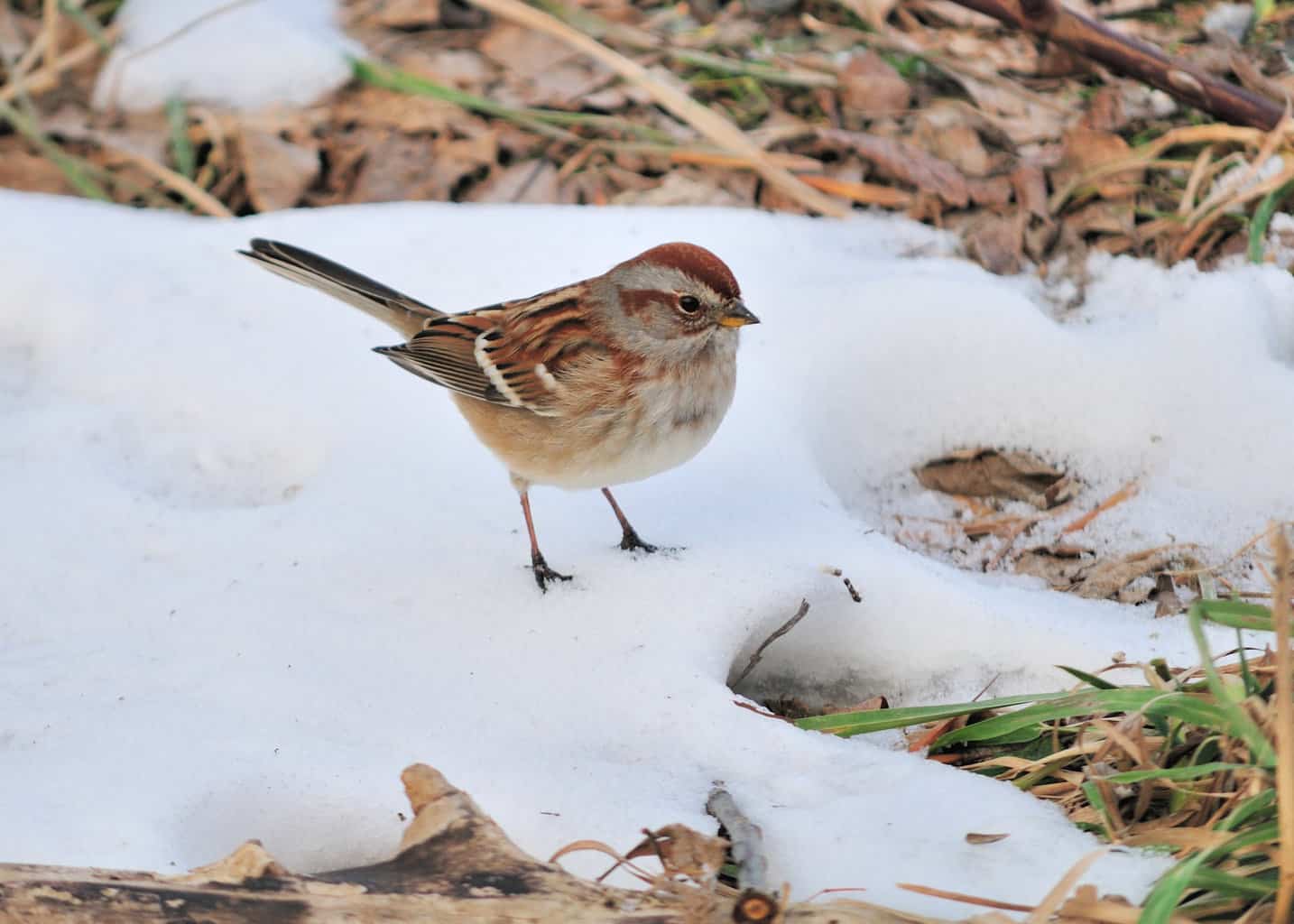
- Scientific Name: Spizelloides arborea
- Length: 5.5 in (14 cm)
- Weight: 0.5-1.0 oz (13-28 g)
- Wingspan: 9.4 in (24 cm)
Despite their name, tree sparrows are normally found near the ground. The misnomer about their habitat is due to their name given by early settlers who simply named this sparrow after their native Eurasian tree sparrows which have a superficial resemblance.
American tree sparrows are most easily recognized by their rusty crowns and eye lines. They’re slightly larger than the similar-looking field sparrow.
Although this species is a fairly common sight during the winter in Connecticut, they’re nowhere to be seen in the summer months. Their nesting grounds are in the far north, even extending into the arctic tundra.
Field Sparrow
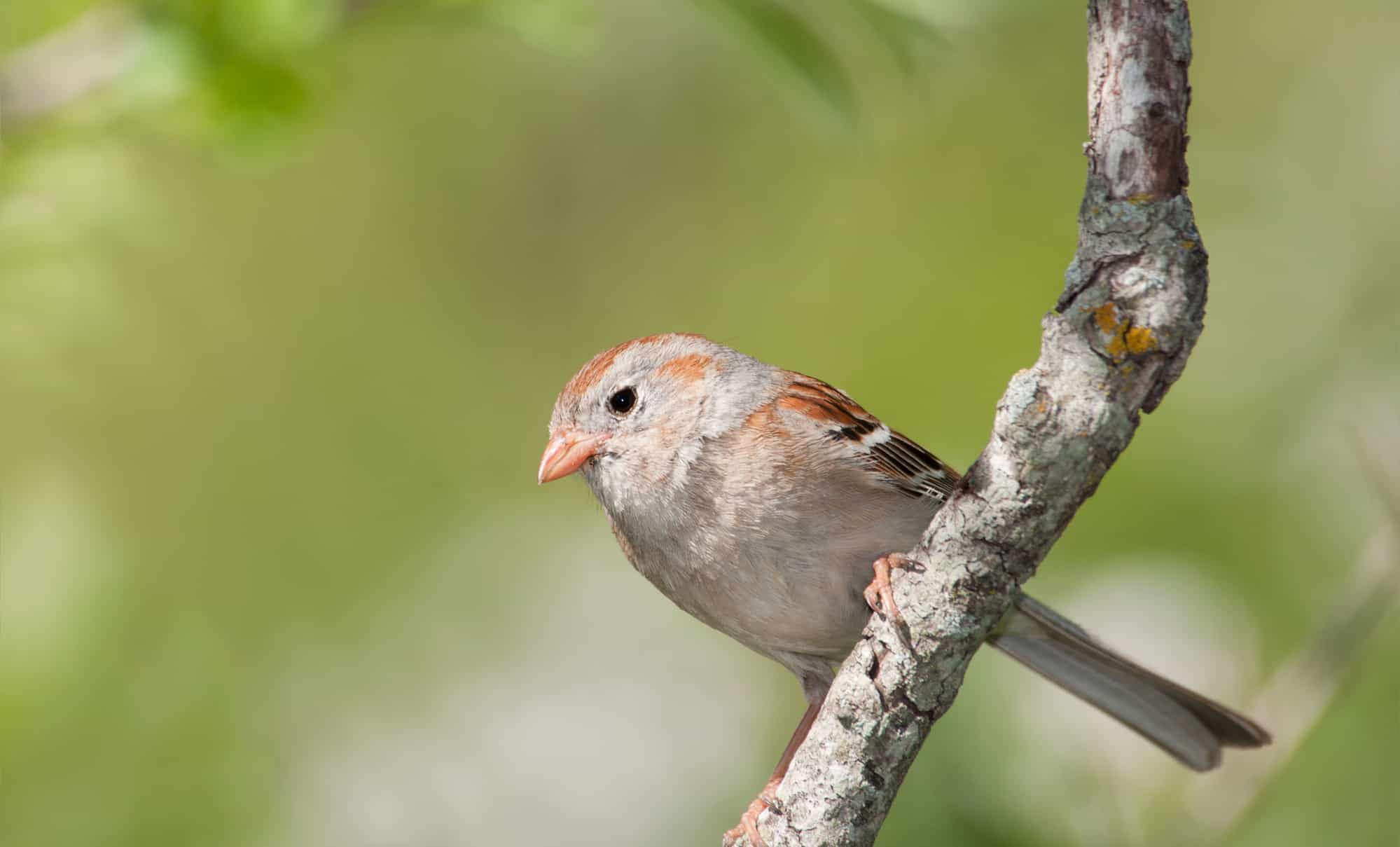
- Scientific Name: Spizella pusilla
- Length: 4.7-5.9 in (12-15 cm)
- Weight: 0.4-0.5 oz (11-15 g)
- Wingspan: 7.9 in (20 cm)
Sharing many of the same visual characteristics as the American tree sparrow and chipping sparrow, the field sparrow is probably more easily identified by their simple song.
Their rapidly accelerating whistles are often likened to a bouncing ball coming to a stop! The call is stronger and clearer than some of their cousins.
Field sparrows are chiefly breeding season migrants in Connecticut, but a few can be found in lower-lying regions of the state during winter too.
Fox Sparrow

- Scientific Name: Passerella iliaca
- Length: 5.9-7.5 in (15-19 cm)
- Weight: 0.9-1.6 oz (26-44 g)
- Wingspan: 10.5-11.4 in (26.7-29 cm)
Of the four subspecies of fox sparrows in North America, the type on the east coast is always the red or Taiga fox sparrows. As their name suggests, their feathers have a slightly reddish tint compared to other fox sparrow types.
These huge sparrows could easily be mistaken for thrushes from a distance. Their speckled chest and habit of scratching about in the undergrowth make them similar in both appearance and behavior.
Their whistling call is almost tuneful enough to pass for that of a thrush as well!
White-crowned Sparrow
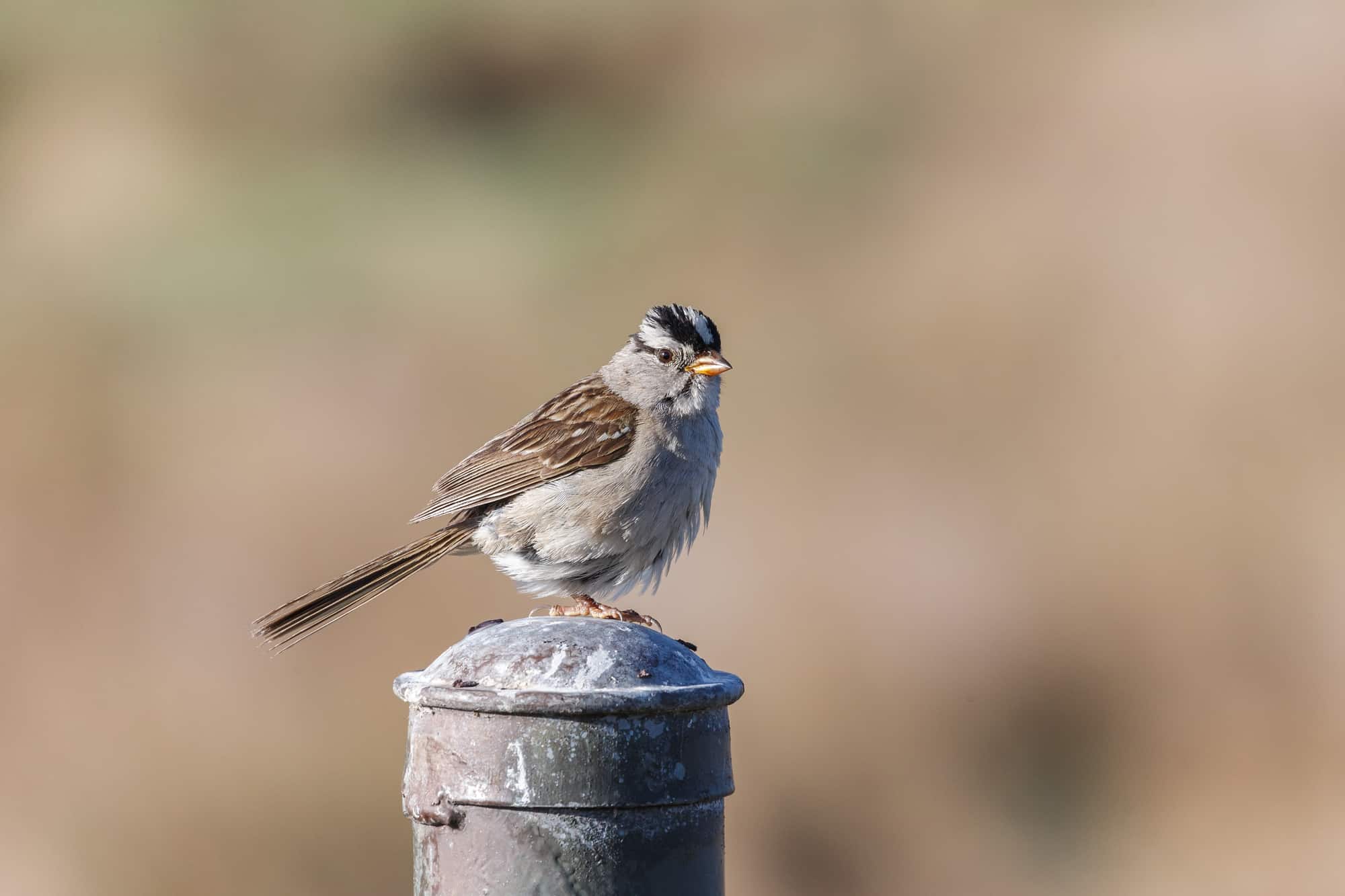
- Scientific Name: Zonotrichia leucophrys
- Length: 5.9-6.3 in (15-16 cm)
- Weight: 0.9-1.0 oz (25-28 g)
- Wingspan: 8.3-9.4 in (21-24 cm)
Although a common sparrow in other parts of North America, the white-crowned sparrow is a relatively infrequent winter migrant in Connecticut. The south of the state represents the northernmost point of this bird’s winter range.
A fairly large sparrow, white-crowned sparrows are fairly easy to identify by the black and white stripes of their crown feathers.
You can attract these birds to your garden by offering them sunflower seeds and cracked corn at your backyard bird feeder.
Saltmarsh Sparrow
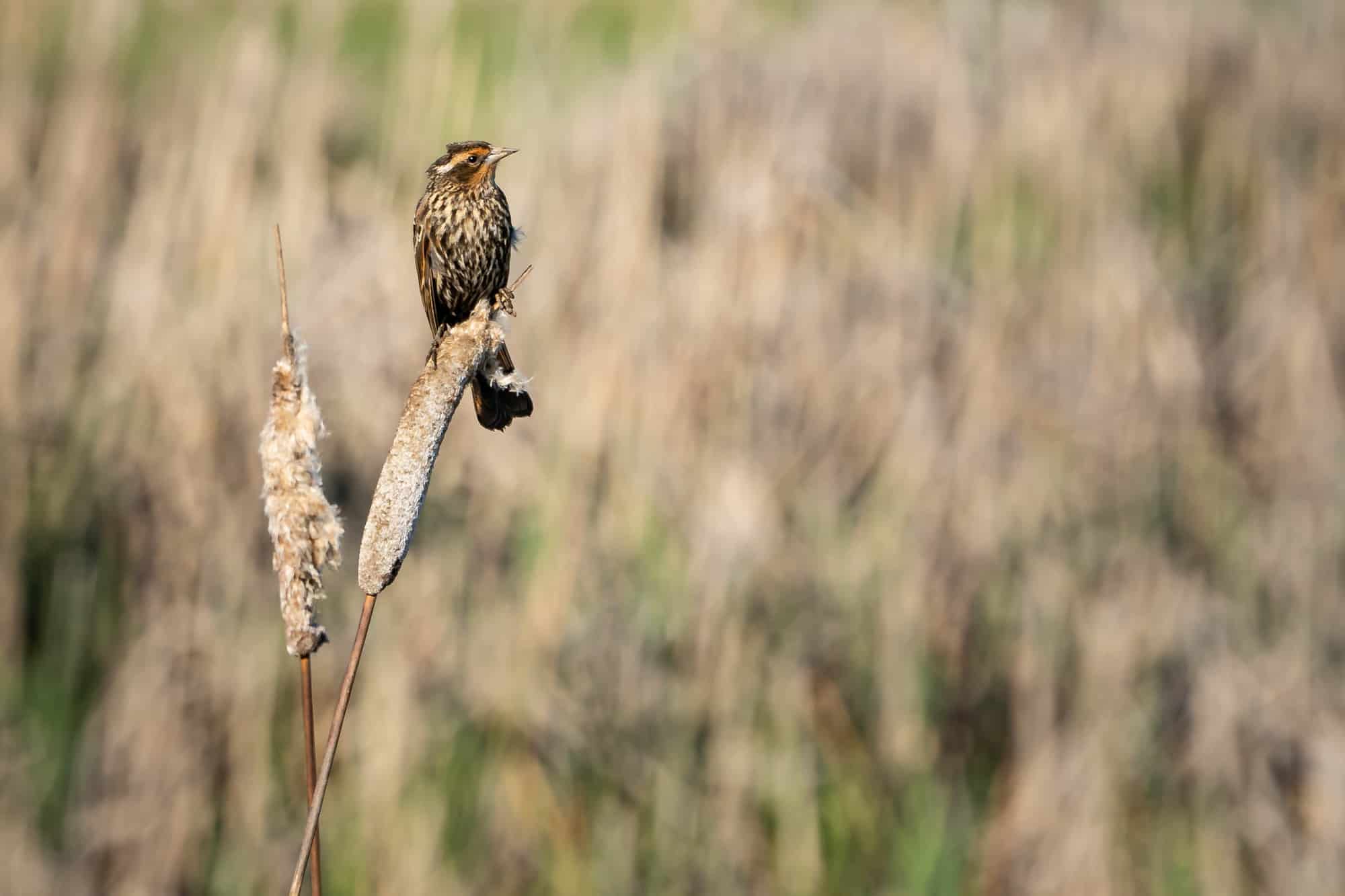
- Scientific Name: Ammospiza caudacuta
- Length: 4.7-5.1 in (12-13 cm)
- Weight: 0.6-0.8 oz (17.1-24.1 g)
- Wingspan: 6.5-7.7 in (16.5-19.5 cm)
The salt marsh sparrow is a resident only on the east coast of the United States, from Maine to Florida.
Although they are not frequently seen around inland parts of the state, they are locally common in Connecticut, preferring coastal marshes where they can forage in the mud.
Their orange face with a black eye line, and soft, gurgling call are the best ways to recognize the salt marsh sparrow.
Seaside Sparrow
- Scientific Name: Ammospiza maritimus
- Length: 5.1-5.9 in (13-15 cm)
- Weight: 0.7-1.0 oz (19-29 g)
- Wingspan: 7.1-7.9 in (18-20 cm)
The seaside sparrow is a close relative of the saltmarsh sparrow but can be distinguished by their slightly larger size, and yellow, rather than orange facial feathers.
The seaside sparrow also has a very large bill that it uses to tease out invertebrates and other tasty morsels from salt marsh habitats.
Like the saltmarsh sparrow, this species is mainly seen in small colonies in Connecticut during the warmer months, but a few may remain here for winter, too.
Grasshopper Sparrow
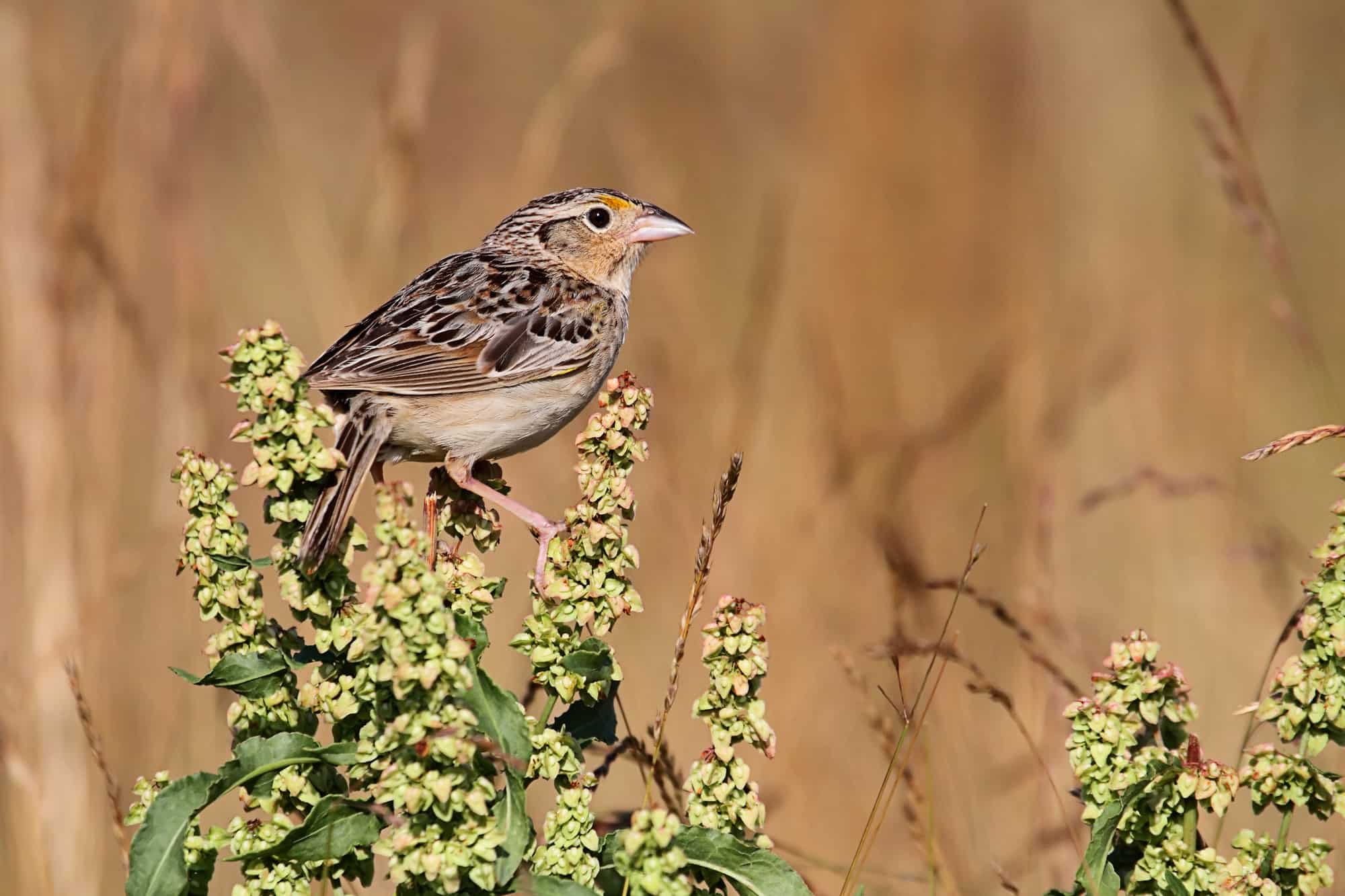
- Scientific Name: Ammodramus savannarum
- Length: 4.3- 5 in (10.8-11.5 cm)
- Weight: 0.5-0.7 oz (14-20 g)
- Wingspan: 7.9 in (20 cm)
Connecticut is strictly only a summer territory for the grasshopper sparrow, a tiny sparrow species which overwinters in the Southern United States and Central America.
Grasshopper sparrows are grassland birds that not only sound like grasshoppers but also love to prey on them! Their buzzy call sounds more like an invertebrate than a bird, and their small size, good camouflage, and small population make this sparrow a prized sighting in Connecticut.
Migratory Sparrow Species in Connecticut
As well as resident species, there are also various other sparrows that pass through Connecticut on the migratory routes in the spring and fall but don’t tend to stop here for long.
The most frequently seen migratory sparrow in Connecticut is Lincoln’s sparrow, which has one of the sweetest songs of any sparrow species.
Others that you might see passing through include the vesper sparrow, Nelson’s sparrow, and the clay-colored sparrow.
Conclusion
15 species of sparrows reside in Connecticut during the summer, winter, or all year round, as well as a few more species that pass through the state on their annual migration routes.
Whether you’re out on the coastline, spotting seaside sparrows and saltmarsh sparrows on the mud flats, or enjoying watching chipping sparrows nesting in your local park, there are plenty of chances to encounter these endearing little birds in Connecticut.
Amazingly, sparrows only make up the tiniest proportion of the whopping 448 bird species in this tiny state! To find out about some of the most fascinating and exotic birds in Connecticut, don’t miss our essential guide here.

